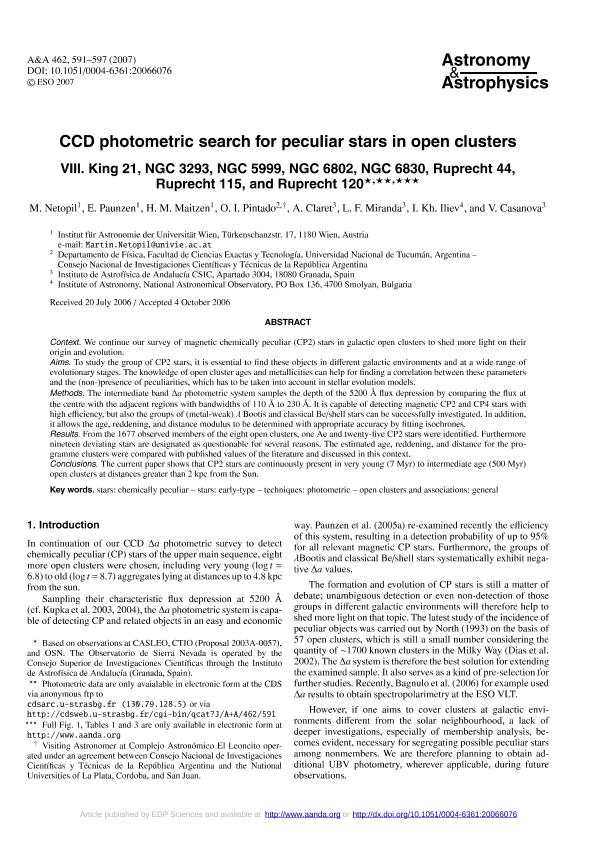Mostrar el registro sencillo del ítem
dc.contributor.author
Netopil, M.
dc.contributor.author
Paunzen, E.
dc.contributor.author
Maitzen, H.M.
dc.contributor.author
Pintado, Olga Ines

dc.contributor.author
Claret, A.
dc.contributor.author
Miranda, L.F.
dc.contributor.author
Hiev, I.Kh.
dc.contributor.author
Casanova, V.
dc.date.available
2020-03-26T14:03:54Z
dc.date.issued
2007-02
dc.identifier.citation
Netopil, M.; Paunzen, E.; Maitzen, H.M.; Pintado, Olga Ines; Claret, A.; et al.; CCD photometric search for peculiar stars in open clusters VIII. King 21, NGC 3293, NGC 5999, NGC 6802, NGC 6830, Ruprecht 44, Ruprecht 115, and Ruprecht 120; EDP Sciences; Astronomy and Astrophysics; 462; 2; 2-2007; 591-597
dc.identifier.issn
0004-6361
dc.identifier.uri
http://hdl.handle.net/11336/100871
dc.description.abstract
Context. We continue our survey of magnetic chemically peculiar (CP2) stars in galactic open clusters to shed more light on their origin and evolution. Aims. To study the group of CP2 stars, it is essential to find these objects in different galactic environments and at a wide range of evolutionary stages. The knowledge of open cluster ages and metallicities can help for finding a correlation between these parameters and the (non-)presence of peculiarities, which has to be taken into account in stellar evolution models. Methods. The intermediate band Δa photometric system samples the depth of the 5200 Å flux depression by comparing the flux at the centre with the adjacent regions with bandwidths of 110 A to 230 A. It is capable of detecting magnetic CP2 and CP4 stars with high efficiency, but also the groups of (metal-weak) λBootis and classical Be/shell stars can be successfully investigated. In addition, it allows the age, reddening, and distance modulus to be determined with appropriate accuracy by fitting isochrones. Results. From the 1677 observed members of the eight open clusters, one Ae and twenty-five CP2 stars were identified. Furthermore nineteen deviating stars are designated as questionable for several reasons. The estimated age, reddening, and distance for the programme clusters were compared with published values of the literature and discussed in this context. Conclusions. The current paper shows that CP2 stars are continuously present in very young (7 Myr) to intermediate age (500 Myr) open clusters at distances greater than 2 kpc from the Sun. © ESO 2007.
dc.format
application/pdf
dc.language.iso
eng
dc.publisher
EDP Sciences

dc.rights
info:eu-repo/semantics/openAccess
dc.rights.uri
https://creativecommons.org/licenses/by-nc-sa/2.5/ar/
dc.subject
OPEN CLUSTERS AND ASSOCIATIONS: GENERAL
dc.subject
STARS: CHEMICALLY PECULIAR
dc.subject
STARS: EARLY-TYPE
dc.subject
TECHNIQUES: PHOTOMETRIC
dc.subject.classification
Astronomía

dc.subject.classification
Ciencias Físicas

dc.subject.classification
CIENCIAS NATURALES Y EXACTAS

dc.title
CCD photometric search for peculiar stars in open clusters VIII. King 21, NGC 3293, NGC 5999, NGC 6802, NGC 6830, Ruprecht 44, Ruprecht 115, and Ruprecht 120
dc.type
info:eu-repo/semantics/article
dc.type
info:ar-repo/semantics/artículo
dc.type
info:eu-repo/semantics/publishedVersion
dc.date.updated
2020-03-11T18:33:35Z
dc.journal.volume
462
dc.journal.number
2
dc.journal.pagination
591-597
dc.journal.pais
Francia

dc.journal.ciudad
Paris
dc.description.fil
Fil: Netopil, M.. Universidad de Viena; Austria
dc.description.fil
Fil: Paunzen, E.. Universidad de Viena; Austria
dc.description.fil
Fil: Maitzen, H.M.. Universidad de Viena; Austria
dc.description.fil
Fil: Pintado, Olga Ines. Consejo Nacional de Investigaciones Científicas y Técnicas. Centro Científico Tecnológico Conicet - Tucumán. Instituto Superior de Correlación Geológica. Universidad Nacional de Tucumán. Facultad de Ciencias Naturales e Instituto Miguel Lillo. Departamento de Geología. Cátedra Geología Estructural. Instituto Superior de Correlación Geológica; Argentina. Consejo Nacional de Investigaciones Científicas y Técnicas. Centro Científico Tecnológico Conicet - San Juan. Complejo Astronómico "El Leoncito". Universidad Nacional de Córdoba. Complejo Astronómico "El Leoncito". Universidad Nacional de la Plata. Complejo Astronómico "El Leoncito". Universidad Nacional de San Juan. Complejo Astronómico "El Leoncito"; Argentina
dc.description.fil
Fil: Claret, A.. Instituto de Astrofísica de Andalucía - Csic;
dc.description.fil
Fil: Miranda, L.F.. Instituto de Astrofísica de Andalucía - Csic;
dc.description.fil
Fil: Hiev, I.Kh.. National Astronomical Observatory Rozhen; Bulgaria
dc.description.fil
Fil: Casanova, V.. Instituto de Astrofísica de Andalucía - Csic;
dc.journal.title
Astronomy and Astrophysics

dc.relation.alternativeid
info:eu-repo/semantics/altIdentifier/doi/https://doi.org/10.1051/0004-6361:20066076
dc.relation.alternativeid
info:eu-repo/semantics/altIdentifier/url/https://www.aanda.org/articles/aa/pdf/2007/05/aa6076-06.pdf
Archivos asociados
